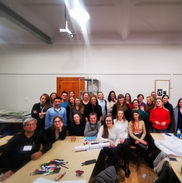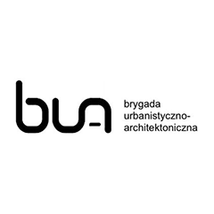
CORE THEME
In the name of The Mentor & Student Research Lab’s team, we are very pleased to invite you to participate in the third edition of The Mentor & Student Research Lab (MSRL) titled "The Public Spaces of Tomorrow" and answer this call. MSRL is organized jointly by the Faculty of Architecture at Gdansk University of Technology, the International Society of City and Regional Planners (ISOCARP), the Polish Society of Town Planners (TUP) and Brygada Urbanistyczno-Architektoniczna (BUA). As an established educational and research project (we invite you to read more on our website and attached brochure), MSRL will allow you to lead a dedicated team of students, in a research of your own design with the cooperation of a mentor.
The main aim of MSRL is to create a space for collaboration between professionals and students in the field of urban studies. MSRL aims to provide a framework for the exchange of experience of the mentors with the initiative and creative energy of young designers and researchers. For the student participants, MSRL gives a good chance to gain research experience in an international work environment with the mentor's support; and the PhD students lead and supervision. For the participating mentors, the project creates an opportunity to conduct research in their field of expertise with the cooperation of a dedicated and enthusiastic team of local participants. The quality of the work is ensured through the supervision of the academic partners from the Gdansk University of Technology.
We plan to work on the basis of the Public Space Manual, created in the first edition of the project. The Manual is a practical guidebook for designers. The public spaces act as a central focal point of social activities and impacts on the physical and mental well-being of the residents. Their use, physical character, social dimension is closely tied to the character of the city and its changes within the city. The aim of the project is to update the Manual taking into account the new and emerging practical aspects of public space design.
MSRL 3.0. SUGGESTED TOPICS
What is the gendered nature of the public space? How can we gender create safer and more inclusive cities? Do different genders use public spaces in different ways? How can public space bring gender equality? What’s the role of women in the creation of public spaces?
What’s the role of public spaces for immigrants? Might immigrants be using the public space for different purposes than locals? How to engage immigrant communities in the creation of new public spaces? How can the institutional invisibility of certain immigrants be taken into account when designing public spaces?
How communities affect the creation of public spaces? How self-organization is changing the role of planners and governments? How informality can be included in formal developments? How institutions can use self-organization and co-creation as city making instruments?
What is the gendered nature of the public space? How can we gender create safer and more inclusive cities? Do different genders use public spaces in different ways? How can public space bring gender equality? What’s the role of women in the creation of public spaces?
What’s the role of public spaces for immigrants? Might immigrants be using the public space for different purposes than locals? How to engage immigrant communities in the creation of new public spaces? How can the institutional invisibility of certain immigrants be taken into account when designing public spaces?
How design can influence the degree of impact of extreme weather events? Which are the design strategies that can help us alleviate rising average temperatures and the effects of sudden downbursts? How can we adapt existing infrastructures for the effects of climate change?
How local solutions and giving more power to places and people counteracts globalisation? What are the benefits of neo-localism guided policy programmes? What role do we want for families and culture in the public spaces of tomorrow? How does the neoliberal market affect local public spaces?
How is Big Data currently being used by planners? What can we achieve through its use when designing public spaces? What is the impact of large data sets that is constantly produces in the urban environment? Can public spaces be shaped in real time when at the same time urban data is produced by users? Can Big Data be used as a collective tool for public participation?
SAVE THE DATES

RESEARCH TEAM


MSRL IN NUMBERS

MSRL PREVIOUS EDITIONS
MSRL OUTCOMES
TO BE
DEVELOPED
DURING THIS EDITION
WE HAD GREAT TIME TOGETHER
RECOMMENDATIONS
Ric Stephens, President, ISOCARP and former MSRL mentor
‘The Mentor&Student Research Lab is an extraordinary programme that combines
research, field work and collaborative design.
This integrated approach yields a variety of innovative findings, recommendations, as
well as planning and design solutions.
For everyone involved, it is a meaningful and memorable experience.’
Markus Appenzeller (Netherlands China), mentor
‘The MSRL program is a very good way for students to understand research and what it
could mean. It was both inspiring and fun to work with motivated people on a subject for
Ia limited amount of time and it would be great if there was an opportunity to expand that further.’
Christian Horn (France, Germany), mentor
‘A rare occasion for interested students to think out of the box and see the big picture.
And a challenging initiative based on the strong commitment of all participants and organisers.’
Oscar Bragos (Argentina), mentor
‘The program has designed and implemented an innovative modality, while attractive,
agile and dynamic, to produce studies on the contemporary city in a relatively short time.
A pattern of work that gets to bring students of different disciplines related to the study
of the organisation of cities. And along with those students achieve an interesting final
product.
It is a form of work that immediately puts students in contact with a particular problem, analyse it and interpret it. A new modality that should continue and be replicated elsewhere since IT manages to interest students in the exciting topic of the management of cities.’
* from the MSRL publication Urban transformations. Towards wiser cities and better living edited by Sławomir Ledwon & Hanna Obracht-Prondzynska
MENTORS
Ronit Davidovich
ISRAEL
Rajendra Kumar
INDIA
Sławomir Ledwoń
POLAND/QATAR
Lim Swee Keng
SINGAPORE
Karolina Wojnowska - Paterek
SINGAPORE
Elisabeth Belpaire
SWITZERLAND
APPLY - till 21 November
send your application to msrl3.0.org@gmail.com

-
research proporsal
-
cv


-
area of interest
-
cv
TO DOWNLOAD
TEAMS
TEAM 1 - RONIT DAVIDOVICH
ILIRJANA
HAXHIAJ
DARIA SHABASHOVA
TEAM 2 - RAJENDRA KUMAR
SYLWIA SITNIEWSKA
WERONIKA
RODAK
GRZEGORZ BANASZEK
NATALIA
PROKOPOWICZ
JANUAR ARIF
KURNIAWAN
JULIA KUREK
PATRYCJA JADWIGA SANKOWSKA
TEAM 3 - SŁAWOMIR LEDWOŃ
JOANNA JACZEWSKA
MEAGHAN MCSORLEY
JETA
BEJTULLAHU
AGATA FATMA ABDELGADER
MICHAŁ
DEJA
ALEKSANDRA ROGUSZEWSKA
TEAM 4 - LIM SWEE KENG & KAROLINA WOJNAROWSKA-PATEREK
ALEKSANDRA RUDNICKA
KATARZYNA KLANCKO
IFEOMA
UKONZE
BAYRAKTAR
SELIM
TEAM 5 - ELISABETH BELPAIRE
MARTA
POPASZKIEWICZ
MANAR
ABDELHAMEED
ANNA
RUBCZAK
ARLETA
SZOMBORG
MARTA
BINEROWSKA
SANDRA
WOJEWSKA
FAEZ
IBRAHIM
WHO WE ARE
Magdalena Draheim
Project Coordinator
architecture student at Gdańsk University of Technology
Hanna Obracht-Prondzyńska
Project Coordinator
Assistant at the Department
of Urban Design and Regional Planning
Gdansk University of Technology
Sławomir Ledwoń
Project Supervisor
Zeynep Gunay
ISOCARP Vice President
Young Planning Professionals
FIRST MEETING

GROUP'S TOPICS
The Public Space as a catalyst of `togetherness` in the global city
Globalism often comes in pair together with loneliness. Why do we so often forget the importance of relationships while designing city spaces? The team calls for “togetherness”. which can only be successful once, in the global world, we – the planners – focus on the localism. In their research, they seek for answers what makes the public spaces liveable? And further, what enhances the process of building an inclusive community participating in urban activates.
#MSRL #globalcity #inclusivepublicspaces #liveablepublicspace # togetherness
Designing public space of tomorrow in context of the climate change
Adaptability for climate changes is one of the biggest challenges for the cities. As planners, we ask ourselves what kind of environmental issues resulting from the current processes, influence the development of the public space? The group tackle the problem of preparing effective policies and evidence-based solutions for environmentally friendly planning. Moreover, they aim to provide recommendations for communicating and engaging societies in shaping the complex matter of climate-adaptive public spaces.
#MSRL #resilitentcity #adaptablecity #climatechanges #evidencebasedplanning
#climateadaptivepublicspaces
ActiCity – how to make people move
The WHO reports state that the levels of physical inactivity are rising in many countries. This has major implications on the general health of people worldwide and for the prevention of common diseases. At the same time, we, the planners, know the urban environment can encourage or discourage the inhabitants to be active. How to formulate recommendations for designing urban strategies enhancing the activeness of public spaces? The team aims to find solutions for cities to get people outside, with special attention to non-traditional and neglected types of movement in urban planning.
#MSRL #walkablecity #activecity #activeresidents #activepublicspaces #liveablepublicspace
A regenerative approach in the design of public spaces - the Design
that Enables Zero Plastic Waste
As the urban challenges are growing rapidly there is a need to shift the urban paradigm from the sustainable to regenerative approach in the city planning processes. We are running out of world resources, therefore, achieving the positive balance while implementing urban solutions should be one of our aims. For this reason, the group challenge themselves to define the potential of reuse of plastic waste in public space design. How can art in public spaces contribute to educating people? They focus on finding an answer for how the social awareness of environmental issues can be improved by the design of public spaces?
#MSRL #regenerativeapproach #reuseofplastic #regenerativepublicspaces
#wastemanagment
Children in public spaces - defining the design features of public spaces to be children 0-5 and they caretakers friendly
Urban discussion tackle more and more often the issue of designing accessible and inclusive public spaces. More importantly, they should be inviting for all city dwellers to participate in urban activities. However, we can still find the lack of kid’s friendly infrastructure in old and new public spaces. So why not to solve them? By opening the online discussion, the group aims to formulate the design recommendations for shaping and improving the public spaces so they are more accessible and friendly for children at the age of 0-5 and they caretakers.
#MSRL #publicspaceinclusivness #publicspacesforall #theyoungestresidents
#urbaninfrastructureandkids #urbankids #urbancaretakers
PARTNERS


























































